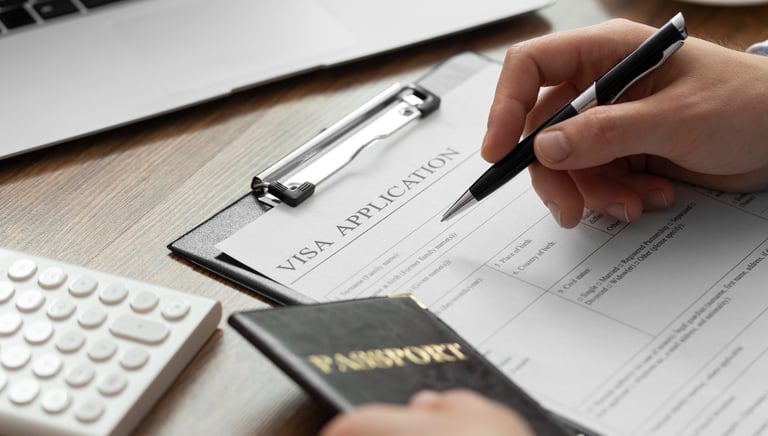Italy’s Work Visa Process: A Step-by-Step Guide for Non-EU Citizens
ITALY
10/18/20244 min read


Can Foreigners Work in Italy?
Yes, foreigners can work in Italy, provided they meet certain legal requirements:
EU/EEA/Swiss Citizens: They can work in Italy with minimal formalities. For stays longer than 90 days, they must apply for a residence permit and obtain a declaration of presence from the local police.
Non-EU Citizens: They must secure a job offer, obtain a work permit (Nulla Osta al lavoro), and then apply for a work visa and residence permit.
Types of Work Visas in Italy
Italy offers different types of long-term work visas, also known as National Visas (Visa D), for individuals planning to work for more than 90 days. The main categories are:
Salaried Employment Visa: Sponsored by an employer and valid for up to 2 years, renewable for a total of 5 years.
Self-Employment Visa: For those starting or moving their business to Italy. It’s valid for up to 2 years.
Long-Term Seasonal Work Visa: Available to workers in agriculture and tourism, valid for up to 9 months.
Working Holiday Visa: For young adults wishing to work while holidaying in Italy, valid for up to 12 months.
The Process of Obtaining a Work Visa in Italy
There are five primary steps to securing a work visa for Italy:
Find a Job: Secure a job offer in Italy, where the employer is willing to sponsor your work permit.
Employer Applies for Work Permit: Your employer applies for the Nulla Osta al lavoro (work authorization) at the nearest immigration office (Sportello Unico per l’Immigrazione).
Work Permit Issuance: Once approved, the employer sends you the Nulla Osta, and the local Italian consulate or embassy is notified.
Apply for Work Visa: You have 6 months from receiving the Nulla Osta to apply for a work visa at your nearest Italian consulate or embassy.
Collect Your Visa and Enter Italy: Once your visa is granted, you have 6 months to collect it and enter Italy.
Documents Required for a Work Permit
Your employer will need the following documents to apply for a work permit on your behalf:
A copy of your valid passport or ID.
Proposed work contract, including details on employment terms, duration, salary, and social security.
Employer’s registration details (e.g., Chamber of Commerce number).
A signed stay contract (Contratto di soggiorno) confirming accommodation and repatriation arrangements.
Documents Required for a Work Visa
When applying for a work visa, you will need:
Completed Long-Stay Visa Application Form.
Proof of visa fee payment (€116).
A copy of your employment contract.
The original and copy of the Nulla Osta.
A valid passport with copies.
Two recent passport photos.
Proof of accommodation in Italy.
Financial proof.
Flight itinerary.
Health and travel insurance covering Italy.
Any additional supporting documents (e.g., diplomas).
The Work Visa Quota System: Decreto Flussi
Italy’s work visa system is governed by the Decreto Flussi, which sets an annual limit on the number of work permits issued. For 2024, the Italian government set a quota of 151,000 work permits, broken down as follows:
89,050 for seasonal workers (e.g., agriculture, tourism).
61,950 for non-seasonal workers.
800 for self-employed workers.
Key Dates for 2024:
February 5: Applications open for non-seasonal workers from countries with labor agreements.
February 7: Applications open for all other non-seasonal workers.
February 12: Applications open for seasonal workers.
Due to high demand, applications often close within minutes of opening, so it’s essential to apply as early as possible.
After Arrival: Important Next Steps
Once you arrive in Italy, there are several essential steps to complete:
Sign the Stay Contract: Within 8 days of arrival, you must sign the Contratto di soggiorno at the Immigration Single Desk (ISD) and apply for your residence permit at the post office. The fee is €76.46.
Sign the Integration Agreement: For stays longer than a year, you’ll sign an agreement committing to:
Learn Italian to at least A2 level.
Attend a civic education course on life in Italy.
Earn 30 points through completing these activities to renew your residence permit.
Register with the Municipality: All residents must register with the Ufficio Anagrafe in their local municipality.
Obtain Your Codice Fiscale: You’ll need this tax identification number for tasks like opening a bank account, signing rental agreements, and accessing healthcare.
Healthcare Registration: Register with the Italian National Health Service (SSN) for healthcare access.
Open a Bank Account: Bring your passport, Codice Fiscale, and proof of employment to open an account. Many banks also allow online registration.
Conclusion
The process of securing a work visa in Italy can be complex and time-sensitive, particularly given the quota system. However, with proper preparation, it’s entirely possible to successfully navigate the system. If you’re ready to make the move, now’s the time to start your job search and plan your future in Italy.
Now that you're familiar with Italy’s work visa requirements, you can begin looking for rental homes in exciting cities like Rome or Milan. Safe travels and good luck with your move!
If you’re a non-EU citizen interested in working in Italy, it’s crucial to understand the unique and time-sensitive nature of Italy’s work visa system. Italy operates under a quota-based system, which limits the number of work visas issued annually, with applications only accepted during specific months. Preparation is key to ensuring a smooth process, and in this post, we’ll walk you through the essential steps, from finding employment to securing your residence permit.
